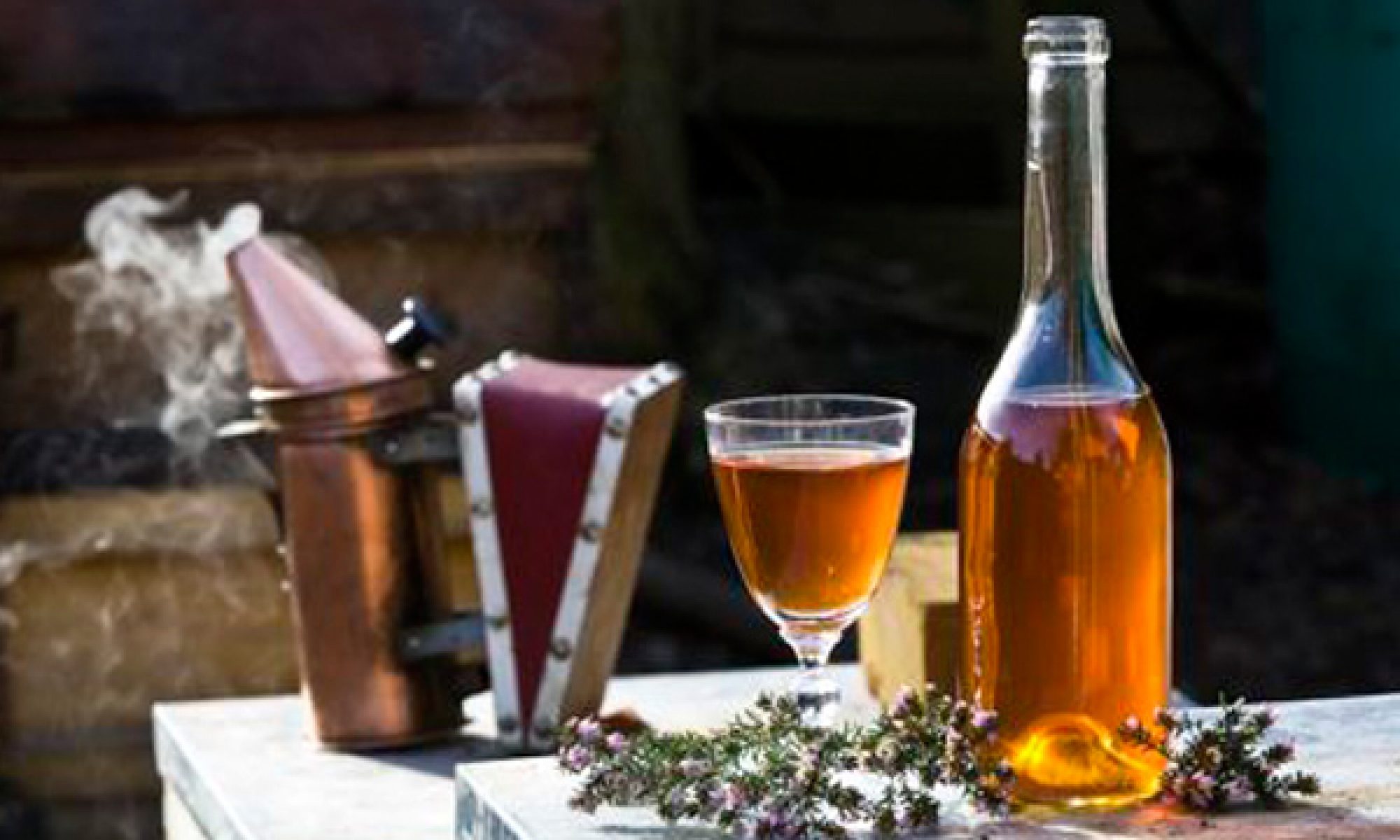Pottery vessels dating from 7000 BCE discovered in northern China have shown chemical signatures consistent with the presence of honey, rice, and organic compounds associated with fermentation.[16][17][18] In Europe, it is first described from residual samples found in ceramics of the Bell Beaker Culture (c. 2800–1800 BCE).[19]
The earliest surviving description of mead is possibly the soma mentioned in the hymns of the Rigveda,[20] one of the sacred books of the historical Vedic religion and (later) Hinduism dated around 1700–1100 BC. During the Golden Age of ancient Greece, mead was said to be the preferred drink.[21] Aristotle (384–322 BCE) discussed mead in his Meteorologica and elsewhere, while Pliny the Elder (23–79 CE) called mead militites in his Naturalis Historia and differentiated wine sweetened with honey or “honey-wine” from mead.[22] The Hispanic-Roman naturalist Columella gave a recipe for mead in De re rustica, about 60 CE.

A mention of “meodu scencu” (mead-cup) in the Beowulf
There is a poem attributed to the Brythonic-speaking (Welsh) bard Taliesin, who lived around 550 CE, called the Kanu y med or “Song of Mead”.[27] The legendary drinking, feasting and boasting of warriors in the mead hall is echoed in the mead hall Din Eidyn (modern-day Edinburgh) as depicted in the poem Y Gododdin, attributed to the poet Aneirin who would have been a contemporary of Taliesin. In the Old English epic poem Beowulf, the Danish warriors drank mead. In both Insular Celtic and Germanic poetry, mead was the primary heroic or divine drink, see Mead of poetry.
Later, taxation and regulations governing the ingredients of alcoholic beverages led to commercial mead becoming a more obscure beverage until recently.[28] Some monasteries kept up the traditions of mead-making as a by-product of beekeeping, especially in areas where grapes could not be grown.
The English mead – “fermented honey drink” – derives from the Old English meodu or medu, and Proto-Germanic, *meduz.[29] The name has connections to Old Norse mjöðr, Middle Dutch mede, and Old High German metu, among others.[29]
Meads will often ferment well at the same temperatures in which wine is fermented, and the yeast used in mead making is often identical to that used in wine making (particularly those used in the preparation of white wines). Many home mead makers choose to use wine yeasts to make their meads.[30]
By measuring the specific gravity of the mead once before fermentation and throughout the fermentation process using a hydrometer or refractometer, mead makers can determine the proportion of alcohol by volume that will appear in the final product. This also serves to troubleshoot a “stuck” batch, one where the fermentation process has been halted prematurely by dormant or dried yeast.[31][32]
After primary fermentation slows down significantly the mead is then racked into a second container. This is known as secondary fermentation. Some larger commercial fermenters are designed to allow both primary and secondary fermentation to happen inside of the same vessel. Racking is done for two reasons: it lets the mead sit away from the remains of the yeast cells (lees) that have died during the fermentation process. Second, this lets the mead have time to clear. The cloudiness could have been caused by either yeast[33] or suspended protein molecules.[32] There also the possibility that the pectin from any fruit that is used could have set which gives the mead a cloudy look.[32]The cloudiness can be cleared up by either “cold breaking,” which is leaving the mead in an cold environment overnight, or using a fining material, such as sparkolloid, bentonite, egg white, or isinglass.[32] If the mead maker wishes to backsweeten the product or prevent it from oxidizing, potassium metabisulfite and potassium sorbate are added. After the mead clears, it is bottled and distributed.
Mead can have a wide range of flavors depending on the source of the honey, additives (also known as “adjuncts” or “gruit“) including fruit and spices, the yeast employed during fermentation, and the aging procedure.[34] Some producers have marketed white wine sweetened and flavored with honey after fermentation as mead, sometimes spelling it “meade.”[34] This is closer in style to a hypocras. Blended varieties of mead may be known by the style represented; for instance, a mead made with cinnamon and apples may be referred to as either a cinnamon cyser or an apple metheglin.

Slovak Medovina or Včelovina Apimed. The mead is produced in the city of Trnava and has won international recognition during the Mazer Cup. This particular mead is brewed in an old Slavic Style.[35]
A mead that also contains spices (such as cloves, cinnamon or nutmeg), or herbs (such as meadowsweet, hops, or even lavender or chamomile), is called a metheglin /mɪˈθɛɡlɪn/.[36][37]
A mead that contains fruit (such as raspberry, blackberry or strawberry) is called a melomel,[38] which was also used as a means of food preservation, keeping summer produce for the winter. A mead that is fermented with grape juice is called a pyment.[38]
Mulled mead is a popular drink at Christmas time, where mead is flavored with spices (and sometimes various fruits) and warmed, traditionally by having a hot poker plunged into it.[citation needed]
Some meads retain some measure of the sweetness of the original honey, and some may even be considered as dessert wines. Drier meads are also available, and some producers offer sparkling meads.
There are faux-meads, which are actually wines with honey added after fermentation as a sweetener and flavoring.[39]
Historically, meads were fermented with wild yeasts and bacteria (as noted in the recipe quoted above) residing on the skins of the fruit or within the honey itself. Wild yeasts can produce inconsistent results. Yeast companies have isolated strains of yeast which produce consistently appealing products. Brewers, winemakers and mead makers commonly use them for fermentation, including yeast strains identified specifically for mead fermentation. These are strains that have been selected because of their characteristic of preserving delicate honey flavors and aromas.
Mead can also be distilled to a brandy or liqueur strength. A version called “honey jack” can be made by partly freezing a quantity of mead and straining the ice out of the liquid (a process known as freeze distillation), in the same way that applejack is made from cider.
In Finland, a sweet mead called sima is connected with the Finnish Vappu festival (although in modern practice, brown sugar is often used in place of honey[40]). During secondary fermentation, added raisins augment the amount of sugar available to the yeast and indicate readiness for consumption, rising to the top of the bottle when sufficiently depleted. Sima is commonly served with both the pulp and rind of a lemon.

Ethiopian mead (Tej)
Ethiopian mead is called tej (ጠጅ, [ˈtʼədʒ]) and is usually home-made. It is flavored with the powdered leaves and bark of gesho, a hop-like bittering agent which is a species of buckthorn. A sweeter, less-alcoholic version called berz, aged for a shorter time, is also made. The traditional vessel for drinking tej is a rounded vase-shaped container called a berele.
Mead known as iQhilika is traditionally prepared by the Xhosa of South Africa.[citation needed]
Mead in Poland is part of culinary tradition for over a thousand years.[41][better source needed][dubious – discuss]
In the United States, mead is enjoying a resurgence, starting with small home meaderies and now with a number of small commercial meaderies.[42] As mead becomes more widely available, it is seeing increased attention and exposure from the news media.[43][44]

